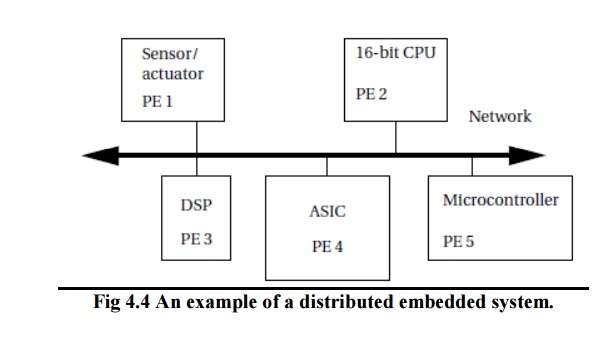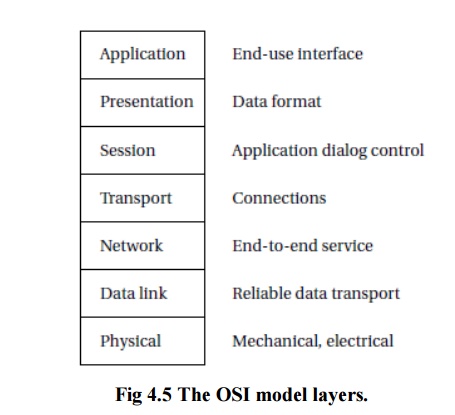Chapter: Embedded and Real Time Systems : Hardware Accelerates & Networks
Distributed Embedded Architectures
DISTRIBUTED EMBEDDED ARCHITECTURES:
A
distributed embedded system can be organized in many different ways, but its
basic units are the PE and the network as illustrated in Figure 4.4. A PE may
be an instruction set processor such as a DSP,
CPU, or microcontroller, as well as a nonprogrammable unit such as the ASICs used to implement PE 4. An I/O device such as PE 1 (which we call here a sensor
or actuator,
depending on whether it provides input or output) may also be a PE, so long as
it can speak the network protocol to communicate with other PEs.
The
network in this case is a bus, but other network topologies are also possible.
It is also possible that the system can use more than one network, such as when
relatively independent functions require relatively little communication among
them. We often refer to the connection between PEs provided by the network as a
communication
link.

The
system of PEs and networks forms the hardware platform on which the
application runs.
In
particular, PEs do not fetch instructions over the network as they do on the
microprocessor bus. We take advantage of this fact when analyzing network
performance the speed at which PEs can communicate over the bus would be
difficult if not impossible to predict if we allowed arbitrary instruction and
data fetches as we do on microprocessor buses.
1. Why Distributed?
Building
an embedded system with several PEs talking over a network is definitely more
complicated than using a single large microprocessor to perform the same tasks.
So why would anyone build a distributed embedded system? All the reasons for
designing accelerator systems also apply to distributed embedded systems, and
several more reasons are unique to distributed systems.
In some
cases, distributed systems are necessary because the devices that the PEs
communicate with are physically separated. If the deadlines for processing the
data are short, it may be more cost-effective to put the PEs where the data are
located rather than build a higher-speed network to carry the data to a
distant, fast PE.
An important advantage of a distributed system
with several CPUs is that one part of the system can be used to help diagnose
problems in another part. Whether you are debugging a prototype or diagnosing a
problem in the field, isolating the error to one part of the system can be
difficult when everything is done on a single CPU. If you have several CPUs in
the system, you can use one to generate inputs for another and to watch its
output.
2. Network Abstractions
Networks
are complex systems. Ideally, they provide high-level services while hiding
many of the details of data transmission from the other components in the
system. In order to help understand (and design) networks, the International
Standards Organization has developed a seven-layer model for networks known as
Open Systems Interconnection (OSI) models [Sta97A]. Understanding the OSI
layers will help us to understand the details of real networks.
The seven
layers of the OSI model, shown in
Figure 4.5, are intended to cover a broad spectrum of networks and their uses.
Some networks may not need the services of one or more layers because the
higher layers may be totally missing or an intermediate layer may not be
necessary.
However,
any data network should fit into the OSI model. The OSI layers from lowest to
highest level of abstraction are described below.
·
Physical:
The
physical layer defines the basic properties of the interface between systems, including the physical
connections ( plugs and wires), electrical properties, basic functions of the
electrical and physical components, and the basic procedures for exchanging
bits.
·
Data
link: The primary purpose of this layer is error detection and control across
a single link. However, if the
network requires multiple hops over several data links, the data link layer
does not define the mechanism for data integrity between hops, but only within
a single hop.

·
Network: This layer
defines the basic end-to-end data transmission service. The network layer is particularly important in
multi hop networks.
·
Transport:
The
transport layer defines connection-oriented services that ensure that data are delivered in the proper order and
without errors across multiple links. This layer may also try to optimize
network resource utilization.
·
Session: A session
provides mechanisms for controlling the interaction of end user services across a network, such as data
grouping and check pointing.
· Presentation: This layer defines data exchange formats and provides transformation utilities to application programs.
· Application: The application layer provides the application interface between the network and end-user programs.
Although
it may seem that embedded systems would be too simple to require use of the OSI
model, the model is in fact quite useful.
Even
relatively simple embedded networks provide physical, data link, and network
services. An increasing number of embedded systems provide Internet service
that requires implementing the full range of functions in the OSI model.
Related Topics